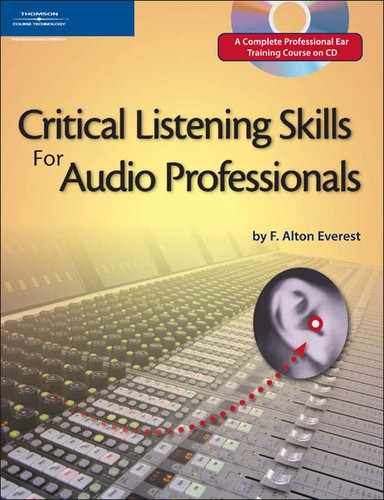Localization Cues From the Outer Ear
We principally depend upon differences in sound pressure level and timing for two-eared localization of sound sources, but is it possible to locate sound with only one ear? Through the years, the tendency has been to answer this question in the negative, but recent findings have given us a new appreciation of the importance of folds, ridges, and depressions of the pinna. Notice that they are asymmetric around the entrance to the auditory canal, called the concha. Sound coming from below, as in Fig. 3A, might be reflected from the top of the concha to the point labeled “x,” which we will take as the center of the opening of the auditory canal. The point of reflection is about half an inch from x, which means that the reflected component travels one inch farther than the component arriving directly at x. Because it takes sound 74 microseconds to travel one inch, the direct and the reflected components will combine at with a delay of 74 microseconds between them. Combining two signals this way results in peaks and nulls throughout the audible spectrum in what is called comb filter distortion, so called because the spectrum plotted on a linear frequency scale looks like a comb. The first null, or dip, occurs at a frequency of 1/(2t) in which “t” is the time delay between the two signals. For the 74 microsecond delay, this first dip falls in the audible spectrum at about 6800 Hz. In Fig. 3B, the center of the auditory canal opening can be taken as 0.375 inch from the concha wall, which results in a delay distance of (2)(0.375 inch) = 0.75 inch. This translates, as above, to a delay of 55 microseconds. A delay of 55 microseconds gives a first dip at 9000 Hz. A similar approach to Fig. 3C, with its quarter inch spacing or half-inch delay distance, yields a dip at 13,500 Hz.
Figure 3. The pinna imposes special filtering on incoming sound through the interaction of direct sound with reflections from irregularities of the pinna. This “comb filtering” produces notches in the spectrum that are interpreted by the brain as directional cues (after Rodgers)

The asymmetry of the pinna around the entrance to the auditory canal yields a first minimum at a frequency dependent upon the angle of arrival of the sound. This seems to be the type of cue a single ear can use to interpret the direction to the source of a sound. This effect is demonstrated in Book 2’s Unit 7.
The total sound pressure acting on the eardrum diaphragm is what actuates the inner workings of the ear. This pressure is affected by the length of the auditory canal, the shape of the head, and the complex of reflections from the pinna interacting with the sound directly entering the canal. This sound pressure not only conveys information on the nature of the source of the sound but also the direction from which it comes. In Fig. 4, the sound arriving directly from the front of the observer is the reference, a fixed sound pressure at all audible frequencies. Sound arriving at the left ear from the left, behind, or the right is markedly different. The ear/brain mechanism interprets these differences to give us directional information.
Figure 4. Variations of sound pressure at the left eardrum for sound arriving from different directions. Sound arriving from the front is taken as the reference. These curves are the average of measurements on 100 subjects, taken in five countries, over a 40-year period (after Shaw and Vaillancourt).

The outer ear is a far more complex system than a tube with a horn on the end of it. Many early books on hearing considered the pinna a vestigial remnant, useful only for collecting sound. However, modern research is revealing the complex acoustical wonders performed by the pinna and the auditory canal.
